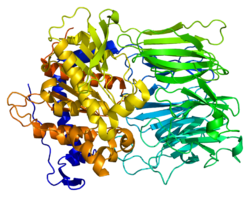Prolyl endopeptidase
| Prolyl endopeptidase | ||
|---|---|---|

|
||
| Properties of human protein | ||
| Mass / length primary structure | 80,751 Dalton / 710 AS | |
| Identifier | ||
| Gene name | PREP | |
| External IDs |
|
|
| Enzyme classification | ||
| EC, category | 3.4.21.26 , serine protease | |
| MEROPS | S09.001 | |
| Response type | Hydrolysis of a trans -Pro-Xaa peptide bond | |
| Substrate | Oligopeptide | |
| Products | Oligopeptide | |
| Occurrence | ||
| Parent taxon | Creature | |
| Orthologue | ||
| human | House mouse | |
| Entrez | 5550 | 19072 |
| Ensemble | ENSG00000085377 | ENSMUSG00000019849 |
| UniProt | P48147 | Q9QUR6 |
| Refseq (mRNA) | NM_002726 | NM_011156 |
| Refseq (protein) | NP_002717 | NP_035286 |
| Gene locus | Chr 6: 105.28 - 105.4 Mb | Chr 10: 45.07 - 45.16 Mb |
| PubMed search | 5550 |
19072
|
Prolyl endopeptidase ( Prolyl-endo-Peptidase , PEP), also called prolyloligopeptidase ( Prolyl-Oligopeptidase , POP) is an enzyme which, as an endopeptidase, separates a specific peptide bond within a short polypeptide and thus cleaves it.
In humans, prolyl endopetidases play a role in the production and breakdown of peptide hormones and neuropeptides . These are serine proteases , as they can be found in all living things. Inhibitors of PEP can increase the concentration of several neuropeptides in the brain; in rats used as experimental animals, this was associated with increased memory performance. PEPs are therefore an interesting target for the pharmaceutical industry .
Genetics and Construction
The for prolylendopeptidase coding PREP - gene is located in humans on 6 chromosome gene locus q22. It consists of 2562 base pairs . No homologous genes have been identified in the human genome .
In humans, the gene product consists of 710 amino acids and has a molar mass of 80,751 Daltons .
function

Prolyl endopeptidase is a proline -specific protease . It cleaves peptides up to a size of usually a maximum of 10 kDa (≈30 amino acids) at the C-terminus of proline (hence the name). One also speaks of a post-proline-cleaving endopeptidase . For this, the proline must be in the trans configuration. In principle, longer proline-containing peptides can also be cleaved if they have an easily unfolded secondary structure and can thus penetrate the central channel of the prolyl endopeptidase via the N-terminus . For example, the 40 kDa p40 Phox protein can be cleaved by means of prolyl endopeptidase.
Even if the structure, catalytic mechanism and substrate specificity of PEP are largely known, knowledge about the physiological function of this enzyme is still very vague. PEP appears to play a role in a number of mental disorders and neurodegenerative diseases . In some diseases, such as bipolar disorders and schizophrenia , the activity of prolyl endopeptidase is increased, in others, such as Alzheimer's , Parkinson's , Lewy body dementia and Huntington's chorea, decreased. It is therefore assumed that PEP is involved in neurodegenerative processes. This is also suggested that administration of the antiepileptic drug valproic acid or of the antidepressant fluoxetine ( Prozac ), the activity of PEP in the serum can be lowered to normal values. A number of specific inhibitors for prolyl endopeptidase are now known. For example the alkaloid berberine or the flavonoid baicalin . In the mouse animal model, PEP inhibitors are able to partially or even completely remedy induced memory disorders. Some of these compounds are in clinical trials as potential nootropics or antidepressants . However, the exact molecular mechanisms via the influence of PEP are still largely unclear.
Occurrence
The enzyme was first isolated from a woman's uterus in 1971. PEP is found in all mammals , for example in the muscles , kidneys , lungs or the brain . PEP is overexpressed in malignant tumors . In a healthy brain, and there especially in the cerebral cortex and neo striatum , which is activity particularly high. However, it is largely unclear in which cell compartments the enzyme is located. It was detected in the cytosol , in the nucleus , synaptosomally and extracellularly , but the protein sequence suggests a purely intracellular occurrence.
Products
In Germany, food supplements for gluten / wheat sensitivity containing this enzyme are marketed, for example the preparation “Gluteostop”.
further reading
- P. Morain et al .: S 17092: a prolyl endopeptidase inhibitor as a potential therapeutic drug for memory impairment. Preclinical and clinical studies. In: CNS Drug Rev 8, 2002, pp. 31-52. PMID 12070525 (Review)
- K. Toide et al .: A novel prolyl endopeptidase inhibitor, JTP-4819 - its behavioral and neurochemical properties for the treatment of Alzheimer's disease. In: Rev Neurosci 9, 1998, pp. 17-29. PMID 9683325 (Review)
- K. Kimura et al: Prolyl endopeptidase inhibitors derived from actinomycetes. In: Bioscience, Biotechnology, and Biochemistry 61, 1997, pp. 1754-1756. PMID 9362123 (Review)
- K. Nomura: Specificity of prolyl endopeptidase. In: FEBS Lett 209, 1986, pp. 235-237. PMID 3539636
Individual evidence
- ↑ Homologues at OMA
- ↑ Kamei H, Ueki T, Obi Y, Fukagawa Y, Oki T: Protective effect of eurystatins A and B, new prolyl endopeptidase inhibitors, on scopolamine-induced amnesia in rats . In: Jpn J Pharmacol . 60, No. 4, December 1992, pp. 377-80. PMID 1287273 .
- ↑ Li J, Wilk E, Wilk S: Inhibition of prolyl oligopeptidase by Fmoc-aminoacylpyrrolidine-2-nitriles . In: J. Neurochem. . 66, No. 5, May 1996, pp. 2105-12. PMID 8780042 .
- ↑ Venäläinen JI, Garcia-Horsman JA, Forsberg MM, et al. : Binding kinetics and duration of in vivo action of novel prolyl oligopeptidase inhibitors . In: Biochem. Pharmacol. . 71, No. 5, February 2006, pp. 683-92. doi : 10.1016 / j.bcp.2005.11.029 . PMID 16405869 .
- ↑ prolyl endopeptidase. In: Online Mendelian Inheritance in Man . (English)
- ↑ G. van Hoof et al: Cloning and sequence analysis of the gene encoding human lymphocyte prolyl endopeptidase. In: Gene 149, 1994, pp. 363-366. PMID 7959018
- ↑ a b c d e I. Schulz: Dependence of the inositol (1,4,5) triphosphate concentration on prolyl endopeptidase - a new molecular mechanism to explain the influence of prolyl endopeptidase inhibitors on mental and neurodegenerative diseases. Dissertation, Martin Luther University Halle-Wittenberg, 2003.
- ↑ D. Rennex et al .: cDNA cloning of porcine brain prolyl endopeptidase and identification of the active-site seryl residue. In: Biochemistry 30, 1991, pp. 2195-2203. PMID 1900195
- ↑ AC Camargo et al .: Involvement of endo-oligopeptidases A and B in the degradation of neurotensin by rabbit brain. In: J Neurochem 42, 1984, pp. 1758-1761. PMID 6327912
- ↑ WL Taylor et al.: New fluorogenic substrates for a rat brain proline endopeptidase. In: Anal Biochem 105, 1980, pp. 58-64. PMID 7004269
- ↑ A. Moriyama et al: Porcine muscle prolyl endopeptidase and its endogenous substrates. In: J Biochem 104, 1988, pp. 112-117. PMID 2851585
- ↑ G. van Hoof et al: Proline motifs in peptides and their biological processing. In: FASEB J 9, 1995, pp. 736-744. PMID 7601338
- ^ DF Cunningham and B. O'Connor: Proline specific peptidases. In: Biochim Biophys Acta 1343, 1997, pp. 160-186. PMID 9434107
- ↑ T. Hasebe et al .: Involvement of cytosolic prolyl endopeptidase in degradation of p40-phox splice variant protein in myeloid cells. ( Memento of the original from June 2, 2008 in the Internet Archive ) Info: The archive link was inserted automatically and has not yet been checked. Please check the original and archive link according to the instructions and then remove this notice. In: J Leukoc Biol 69, 2001, pp. 963-968. PMID 11404383
- ↑ D. Mantle et al .: Comparison of proline endopeptidase activity in brain tissue from normal cases and cases with Alzheimer's disease, Lewy body dementia, Parkinson's disease and Huntington's disease. In: Clin Chim Acta 249, 1996, pp. 129-139. PMID 8737597
- ↑ M. Maes et al.: Alterations in plasma prolyl endopeptidase activity in depression, mania, and schizophrenia: effects of antidepressants, mood stabilizers, and antipsychotic drugs. In: Psychiatry Res 58, 1995, pp. 217-225. PMID 8570777
- ↑ T. Tarrago et al: The natural product berberine is a human prolyl oligopeptidase inhibitor. In: ChemMedChem 2, 2007, pp. 354-359. PMID 17295371
- ↑ T. Tarragó: Baicalin, a prodrug able to reach the CNS, is a prolyl oligopeptidase inhibitor. In: Bioorganic & Medicinal Chemistry 16, 2008, pp. 7516v7524. PMID 18650094
- ↑ M. Nanri and H. Kaneto: Anti-amnesic effect of prolyl endopeptidase inhibitors in mice. In: Nippon Yakurigaku Zasshi 89, 1987, pp. 323-329. PMID 3305244
- ↑ T. Yoshimoto et al .: Specific inhibitors for prolyl endopeptidase and their anti-amnesic effect. In: J Pharmacobiodyn 10, 1987, pp. 730-735. PMID 3330562
- ↑ R. Walter include: Leucylglycinamide released from oxytocin by human uterine enzymes. In: Science 173, 1971, pp. 827-829. PMID 5572174
- ↑ T. Kato et al .: Distribution of post-proline cleaving enzyme in human brain and the peripheral tissues. In: Mol Cell Biochem 32, 1980, pp 117-121. PMID 7007867
- ↑ a b J. Irarasta et al: Distribution of prolyl endopeptidase activities in rat and human brain. In: Neurochem Int 40, 2002, pp. 337-345. PMID 11792464
- ↑ a b F. M. Goossens et al .: Distribution of prolyl oligopeptidase in human peripheral tissues and body fluids. In: Eur J Clin Chem Clin Biochem 34, 1996, pp 17-22. PMID 8704029
- ↑ R. Mentlein: inter alia: Proline-specific proteases in cultivated neuronal and glial cells. In: Brain Res 527, 1990, pp. 159-162. PMID 2282478
- ↑ ME Gallegos et al: The activities of six exo-and endopeptidases in the substantia nigra, neostriatum, and cortex of the rat brain. In: Neurochem Res 24, 1999, pp. 1557-1561. PMID 10591406
- ↑ K. Dresdner et al: Subcellular distribution of prolyl endopeptidase and cation-sensitive neutral endopeptidase in rabbit brain. In: J Neurochem 38, 1982, pp. 1151-1154. PMID 7038048
- ↑ T. Ishino et al .: cDNA cloning of mouse prolyl endopeptidase and its involvement in DNA synthesis by Swiss 3T3 cells. In: J Biochem 123, 1998, pp. 540-545. PMID 9538240
- ↑ RM O'Leary and B. O'Connor: Identification and localization of a synaptosomal membrane prolyl endopeptidase from bovine brain. In: Eur J Biochem 227, 1995, pp. 277-283. PMID 7851396 .
- ↑ F. Goossens et al: A sensitive method for the assay of serum prolyl endopeptidase. In: Eur J Clin Chem Clin Biochem 30, 1992, pp 235-238. PMID 1525255
- ↑ Dr. Marc Schneider: Specialist information Gluteostop. (PDF) ineo Pharma GmbH, accessed on April 22, 2020 .
Web links
- prolyl endopeptidase (Homo sapiens). Entrez Protein
- Prolyl oligopeptidase with gsk552. EMBL-EBI (English)
